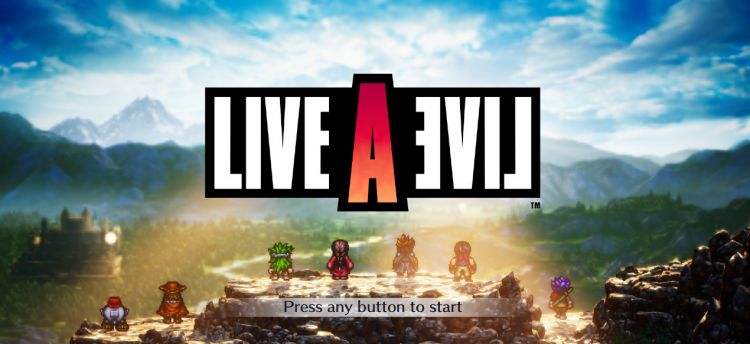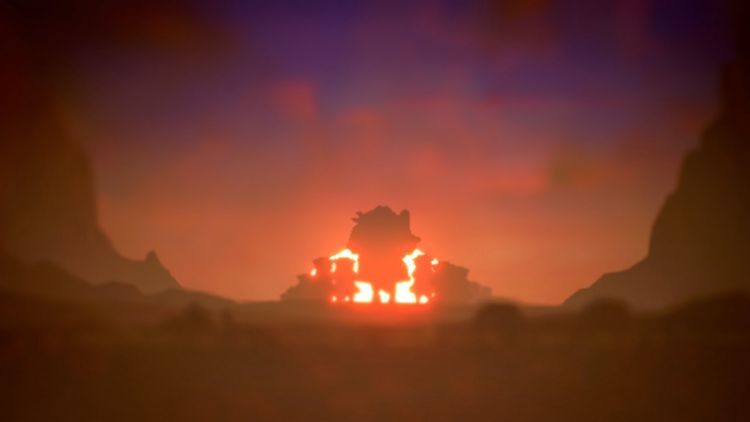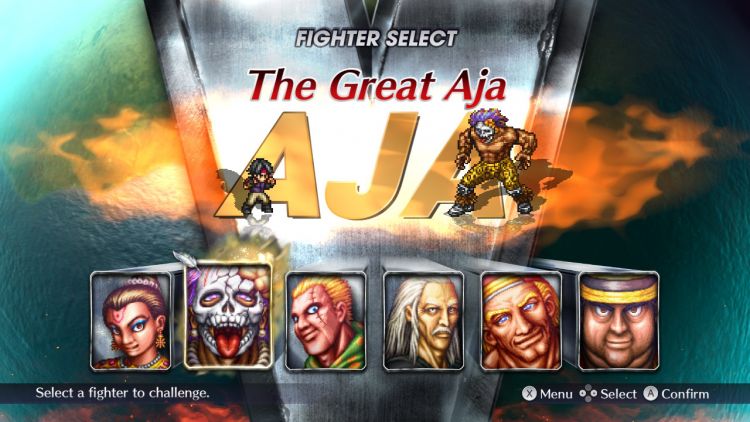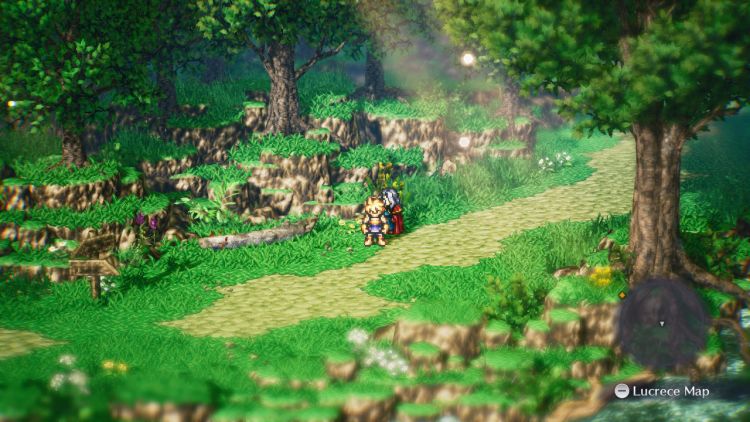I’ll be the first to admit that I had never heard of Live A Live before the Nintendo Direct earlier this year. I didn’t know that this was a game that was on the Super Famicon over 20 years ago and was getting “reborn” due to the 2D-HD graphics that have been made a new style by Square Enix and others. I wanted to give it a try because I really love RPGs.
As this Live A Live Review will show you, this is a game that was ahead of its time then, better in the time now, even though it still had some “bugs” transferred over.
Game Name: Live A Live
Platform(s): Nintendo Switch
Publisher(s): Square Enix
Developer(s): Square Enix
Very loosely, and likely you know by now via the trailers. Live A Live is a game that puts you on 7 different main story paths (to start…), featuring 7 different main characters (to start…), different genres, and overall different stories. The reason this resonated with me was that this was what Octopath Traveler did (overall anyway), but 20 years prior.
To think that the team behind the OG version attempted this on the Super Famicom and was mostly successful is mind-boggling to me, especially when I think about the graphics back then and how we hadn’t “evolved” certain gameplay mechanics. Yet, when you play the remake, it’s pretty wonderful, and you get a taste of just how different RPGs can be even within their own genre.
Easily the thing that struck me the most about the 7 main paths is that not all of them played the same way, which struck me as obvious eventually because it wouldn’t be “as fun” if you were just playing “seven different RPG adventures.” They all have turned-based RPG mechanics in their own way, but how you get to the battles overall is sometimes very different, or in some instances, not the focus.
Case in point, in the Prehistory story, you play a young caveman named Pogo, and his journey is very RPG-like, just without the dialogue. As my Nintendo Entertainment Podcast co-host noted to me, you’ll be surprised by how expressive they get in their grunts and calls. They embrace the caveman “language.” In contrast, in Edo Japan Story, you have a choice to make. You can go on a “blood-soaked mission” to save the country or choose the “stealth path” and only kill when it’s a boss fight.
A choice that many RPGs wouldn’t allow you to make until much later. Meanwhile, in the Distant Future, you play more of a visual novel and just “experience things as they happen” via a robot named Cube and only have one fight throughout the entire story. Yet, it’s still compelling.
Each story has its only unique flair and twist that can’t be ignored. Each episode can be beaten within 1-2 hours, depending on how well you play and how much you “grind.” Overall, you can easily spend over 20 hours in this game doing sidequests, getting better equipment for the final battles, and more.
“But Todd!” you ask, “Are these stories tied together in a meaningful way?” I’ll spoil part of that later, but the main answer is yes. While they don’t look it at first, there is a connecting thread that binds them all together, and to really spoil things, in the final scenario, you’ll get to bring the main 7 together to save all of time and space from a great evil.
I won’t lie; after spending so much time with them individually, it was great to see them work together and interact with one another in a way that was meaningful. Something that even Octopath Traveler struggled to do with its 8 stories.
Another thing that will be very obvious to you as you play the stories is all the references and nods to all the genres and key stories that influenced these tales. There are clear nods to Street Fighter (see picture below for proof of that), just about every Western that Clint Eastwood ever made, Akira (via the story featuring…well…Akira), 2001 A Space Odyssey, various Kung Fu movies, and so on. You’ll want to see all the references you can find, and wonder about ones you may not recognize.
Was it a little on the nose at points? Yes. Like in the Present Day storyline, we have a character who is pretty much Ryu from Street Fighter with a slight twist. But as they say, imitation is the sincerest form of flattery.
Plus, each of the stories at times has fun twists that make them much more than an “imitation.” The Imperial China storyline is a great example of this, same with Edo Japan, the Near Future, and others.
As noted before, the Live A Live remake fully embraces the 2D-HD graphics, and it shows. The game looks stunning at times in how it uses it, especially in spots like the Old West, where they do pans of the two, and you see how well the 3D models look. Or in Prehistory, where the way they rendered the world is pretty cool to look at. I might even make the argument that this is the best-looking of the 2D-HD games that I’ve played (Octopath Traveler and Triangle Strategy being the others), and that’s no small praise.
I will say that I wish they did push things a little better in terms of the “common sprites,” as they did clear copy and past jobs with different color palettes, and at times, it really stands out in a bad way.
The other major improvement from the Super Famicom version is voice acting. From the grunts of cavemen to the ye olde style talk of the Middle Ages, they cover an excellent gambit here, and I’d say the voices hit a lot more than they missed. I can only think of one character who really annoyed me with her voice, and you don’t meet her until the near end. It really helps bring the stories to life when you’re hearing the main voices instead of just reading the on-screen text.
Now we’ve come to the point in my Live A Live Review where I ask, “What did the game get wrong?” Well, in the storyline, that would be the first of two “hidden” chapters in the Middle Ages setting. There, we play a young “destined warrior” who must rally allies old and new to defeat a dark lord. All the standard RPG stuff and they toss in some fun twists to keep it fresh. By the end, we get the twist that a key character from this storyline is the “great evil” that has infected all of time with its hate.
Very cool…but…when we learn what triggered them to get to this point…it honestly doesn’t make sense. Especially since they were “born” AFTER key events had already happened and events were set in motion to start them on the quest in the first place.
Even if you accept the tease of “the evil was always there guiding things,” some of the characters in their dialogue don’t paint a good picture of why the character went evil. Including one essential death that was at best…rather stupid. For the record, it doesn’t ruin the end of the game, but it affected me because I kept trying to figure it out and couldn’t think of the answer.
The second major thing is that some parts of this game…haven’t aged well. Some of the new character sprites are…let’s just say, not tactful. What’s more, while it is a “T” rating, you might be surprised by how vulgar this game can get. I’m not marking it down for it, but in some episodes of the plot, there’s no cussing at all, and others are kind of full of it, which makes an odd balance. And to say that the ending of Prehistory was “not subtle in the slightest” is an understatement.
Arguably most important, while the gameplay mechanics are incredibly solid, and you’ll all find your own favorite characters you want to play with at the end, the game takes a lot of liberties in what it’ll assumes the player will do. For example, I had to redo my Prehistory playthrough (which I did first in terms of order) almost two hours in because I raced into a cave without fearing what might happen next, and I ended up in a boss fight I was severely under-leveled for. So I had to start over from scratch and gain an extra three levels just to manage.
What’s more, for the “stealth run” in Edo, Japan, I’d be shocked if you were able to do that without a guide (hint: I used a guide, and it was STILL complicated). By the time I got to the final boss, I again had an underleveled problem that almost drove me to rage quit. This drove me to grind like crazy, and to acquire the ultimate attacks for three characters, only for the final boss to be laughably easy at points.
There are secret bosses, extra equipment, things you should and shouldn’t do at one point in the game to influence the rest, and more that are at times kind of mind-boggling in terms of why they were put in at all without any clear hints that they’re there. If I wasn’t using a guide for one part of the game (the part I mentioned earlier), I would’ve never known about these things. Speaking of which, in the endgame, you go on a “boss rush” mode, and it expects you to have previously outfitted all 7 of the main characters with the “best equipment possible” to rush through them…I lost one of those matches the first time when my underleveled cowboy got blasted by an attack that did 1000 damage…and I was told later on that this was a “much weaker version” of the previous version I fought. Right…
Finally, while this is an RPG, and “missing” is a part of the game for sure, I can’t tell you how many times I randomly “missed” an attack at the most random and unfortunate of times. Causing me to lose fights and characters as a result. Including in the boss rush when my character hadn’t missed a single time beforehand.
Flaws aside, I hope this Live A Live Review shows you that sometimes a remade RPG can be one of the best things around. Each of these nine total stories stands out in its own way, and I’m glad to have played it. If you try it, you might just feel the same way.
Live A Live Review
Summary
Live A Live is an RPG that was reborn with new life and vigor, and it shows. It’s a solid RPG that weaves all sorts of unique mechanics, stories and genres into one package that is very special indeed.
-
Live A Live Review






